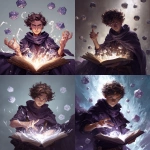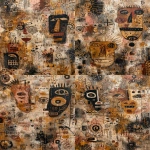Explore the Best AI Image Gallery

Beyond the Canvas: How VR and AR are Transforming Gaming and Creativity
The world of gaming has always been a playground for creativity, where imagination takes center stage. Yet, recent advancements in virtual reality (VR) and augmented reality (AR) have catapulted this realm to unprecedented heights, blurring the lines between the digital and physical worlds and ushering in a new era of immersive experiences.
No longer confined to screens, gamers can now step into meticulously crafted virtual environments, interact with characters and objects in tangible ways, and feel truly present within the game world. This level of immersion not only enhances gameplay but also opens up exciting avenues for creative expression, storytelling, and artistic innovation.
A Canvas Beyond Imagination
VR and AR are revolutionizing game development by providing developers with a dynamic canvas to build upon. Imagine crafting intricate worlds with breathtaking landscapes, realistic character models, and interactive elements that respond to player actions in real-time. This level of detail and interactivity allows for unparalleled storytelling possibilities, enabling creators to transport players into narratives that feel both epic and intimate.
AR, on the other hand, overlays digital content onto the real world, enriching everyday experiences with fantastical elements. Imagine exploring a historical landmark and witnessing virtual recreations of past events unfold around you or interacting with fictional characters who appear alongside your furniture in your living room. This blend of reality and virtuality creates a unique layer of engagement that can transform mundane environments into captivating playgrounds for creativity.
Gaming as an Art Form
VR and AR are not only transforming how games are developed but also pushing the boundaries of what constitutes a game. With their immersive nature, these technologies have paved the way for experiences that blur the lines between gaming and art. Interactive installations, VR performances, and AR-enhanced sculptures are just a few examples of how creativity is flourishing within this evolving landscape.
These new mediums allow artists to experiment with unconventional forms of expression, engage audiences in unprecedented ways, and explore themes that transcend traditional artistic boundaries. By fusing technology with human ingenuity, VR and AR are creating a fertile ground for innovation and artistic exploration.
Ethical Considerations
As with any powerful technology, the rise of VR and AR in gaming brings forth important ethical considerations. The immersive nature of these experiences can raise concerns about player safety, data privacy, and the potential for addiction. It is crucial to establish guidelines and regulations that ensure responsible development and usage of these technologies.
Moreover, the blurring of lines between reality and virtuality raises questions about the impact on social interaction, empathy, and our perception of the world. As we navigate this uncharted territory, it is essential to engage in thoughtful discussions about the ethical implications of VR and AR and strive for a future where these technologies are used responsibly and ethically.
Future Trends
The landscape of VR and AR gaming is constantly evolving, with new advancements emerging at a rapid pace. Here are some exciting trends shaping the future of this dynamic field:
- Enhanced Realism: Advancements in graphics processing, haptic feedback, and motion tracking will continue to push the boundaries of realism, creating immersive experiences that feel indistinguishable from reality.
- Social VR: Virtual worlds will become increasingly social hubs, enabling users to connect, collaborate, and engage in shared experiences with friends and strangers alike.
- Cloud Gaming: Streaming VR and AR games directly to devices will eliminate the need for powerful hardware, making these experiences accessible to a wider audience.
- Personalized Experiences: AI-powered algorithms will tailor game content and storylines to individual player preferences, creating truly personalized and engaging adventures.
The fusion of VR and AR with gaming has ushered in a new era of creativity, pushing the boundaries of storytelling, artistic expression, and interactive entertainment. As these technologies continue to evolve, we can expect even more groundbreaking innovations that will shape the future of gaming and beyond.













](https://images.ai-img.art/thumbnails/150/a6e0de6624101aaef035b92496c700bb604a4cb88994638a5b412846cf7573b1.webp)

](https://images.ai-img.art/thumbnails/150/23882a9f82706d2f7c4b440bda74297aa5e8c3d98540229d103e43300acc9930.webp)








](https://images.ai-img.art/thumbnails/150/9cb82d34ca29daf942fc7c45a304b9195fb34812aad7159ed8b9a6c05a7ee9fb.webp)

](https://images.ai-img.art/thumbnails/150/cd229ab5d344540d5f69681deea952a276d77ca96612476b946b6a1105b3b3c9.webp)

](https://images.ai-img.art/thumbnails/150/5c3d9f2208986dde94f5744ca025c99d989b8b58db3929d33b6cd086977c6f1c.webp)


](https://images.ai-img.art/thumbnails/150/c37048b5bc7f457a0234ef99218d5e8057ebfafc3e859cd7768d5d85088176a9.webp)
